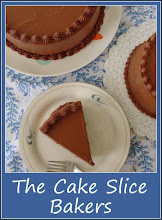On week one we learnt how to make proper royal icing from scratch and how to make piping bags out of greaseproof paper. I was pleased to learn how to do this properly as my attempts in the past have often ended up with a big blob of icing oozing out the wrong end and me getting covered in sticky icing. Hopefully, now I should be more successful. The trick is to start with a triangle and then fold the two corner points into the centre, and form a tight cone shape. Then, fold one edge down to secure it and cut off the tip to give you a fine hole from which to pipe from. You can also add piping nozzles to give a more accurate sized hole.
After practicing some writing and decorative swirls with different nozzles we turned our attention to sugar flowers. There are two ways of forming the petal part of a sugar flower, depending on what sort of flower you wish to make.
The method we were shown first is called the Mexican Hat method. This involves creating a tiny ball of special sugar flower paste (about the size of a pea) and rolling it out in all directions from the very centre, leaving a small hump of paste in the middle, not just rolling it out flat. You then cut out your flower or leave shape with the hump of icing in the centre. You then take a length of florists wire, dip in it edible glue and thread it down from the top and through the hump of icing. You use this excess bit of icing to secure the flower to the wire.
 A few option stamens can then we added into the centre of some flowers. You can then add detail or colour to the flower top. I found this method quite difficult as I couldn’t attach my flowers to the wire very easily (I don’t think my paste hump was big enough) and the edges of my flowers ended up a little scruffy. But it was only a first attempt.
A few option stamens can then we added into the centre of some flowers. You can then add detail or colour to the flower top. I found this method quite difficult as I couldn’t attach my flowers to the wire very easily (I don’t think my paste hump was big enough) and the edges of my flowers ended up a little scruffy. But it was only a first attempt.Another method is to first use the Mexican Hat method
 to attach a green sugar paste calyx to a wire (the green under part of a flower) before rolling another small ball of paste completely flat and stamping out a flower of leave shape. You then dab a bit of glue onto he base of the flat flower and attach it to the top of calyx already attached to a wire. You can add many stamped out petals to the to
to attach a green sugar paste calyx to a wire (the green under part of a flower) before rolling another small ball of paste completely flat and stamping out a flower of leave shape. You then dab a bit of glue onto he base of the flat flower and attach it to the top of calyx already attached to a wire. You can add many stamped out petals to the to p to create a ruffled effect; it also helps if you use a cocktail stick to maneuver the petals into other positions. We were shown this method just before leaving and our homework was to make five of them before the next class. I really enjoyed making these at home but its quite time consuming work. Just making 5 flowers took my an hour and a half of work. You have to place the wires into a sponge so that the flowers can dry without getting squashed.
p to create a ruffled effect; it also helps if you use a cocktail stick to maneuver the petals into other positions. We were shown this method just before leaving and our homework was to make five of them before the next class. I really enjoyed making these at home but its quite time consuming work. Just making 5 flowers took my an hour and a half of work. You have to place the wires into a sponge so that the flowers can dry without getting squashed.In our second week we learnt how to dust our flowers with edible powdered colours. This is done by tapping a little of the powder out onto a work surface and working it into a dry paintbrush, ensuring any small lumps have been removed. It is then carefully brushed onto the flowers. For the ruffled flowers we made at home, we only coloured the edges by holding the flower upside down and drawing the brush down over the ruffles. We tinted the edges pink and then used a yellow to taint the very centre of the flower. Once finished, the flowers are then held for 3 seconds in the steam from a boiling kettle. This melds all the colours into the paste and gives the flowers a glossy look. Be careful not to hold them in the steam for very long or else they’ll melt! They must then be left to dry/set again.
 By the end of the class we were able to group all our flowers together in a bunch and secure the ends using florists tape. I was quite pleased with my little bunch of flowers. It’s amazing how adding a bit of colour can enhance an otherwise dull and rather scruffy looking flower. For our homework that week we had to make a Madeira cake which we would then decorate with our flowers next week.
By the end of the class we were able to group all our flowers together in a bunch and secure the ends using florists tape. I was quite pleased with my little bunch of flowers. It’s amazing how adding a bit of colour can enhance an otherwise dull and rather scruffy looking flower. For our homework that week we had to make a Madeira cake which we would then decorate with our flowers next week.Last week we had to cut and fill our Madeira cakes. I wanted min e to be a bit different and so I flavoured the cake with lime zest and filled it with passion fruit curd and buttercream. The whole cake is then lightly covered in buttercream before being encased in fondant. I was fortunate enough to have enough fondant to cover the base of my board too, but this is not necessary. We then crimped the edges of the cake to add a bit of interest and attached our posy of flowers. One of my ruffled pinks broke off and I decided to add it to one corner of the cake. I think this worked well and
e to be a bit different and so I flavoured the cake with lime zest and filled it with passion fruit curd and buttercream. The whole cake is then lightly covered in buttercream before being encased in fondant. I was fortunate enough to have enough fondant to cover the base of my board too, but this is not necessary. We then crimped the edges of the cake to add a bit of interest and attached our posy of flowers. One of my ruffled pinks broke off and I decided to add it to one corner of the cake. I think this worked well and  help prevent the rest fo the cake form looking bare. I was so chuffed with my cake by the end. I have never produced any kind of delicate decoration before and it really made the cake look special. I still need a lot more practice to get to any sort of professional standard (some people in the class had done them before and theirs looked amazing) but for a first attempt I was very happy.
help prevent the rest fo the cake form looking bare. I was so chuffed with my cake by the end. I have never produced any kind of delicate decoration before and it really made the cake look special. I still need a lot more practice to get to any sort of professional standard (some people in the class had done them before and theirs looked amazing) but for a first attempt I was very happy.
 Apologies for some of the photos. Its always been dark when I’ve got home and taken them.
Apologies for some of the photos. Its always been dark when I’ve got home and taken them.






2 comments:
Beautiful! Well done! Bravo!
Wow your cake looks amazing. The flowers looks so delicate and pretty its almost unbelievable to think they are made of sugar.
Post a Comment